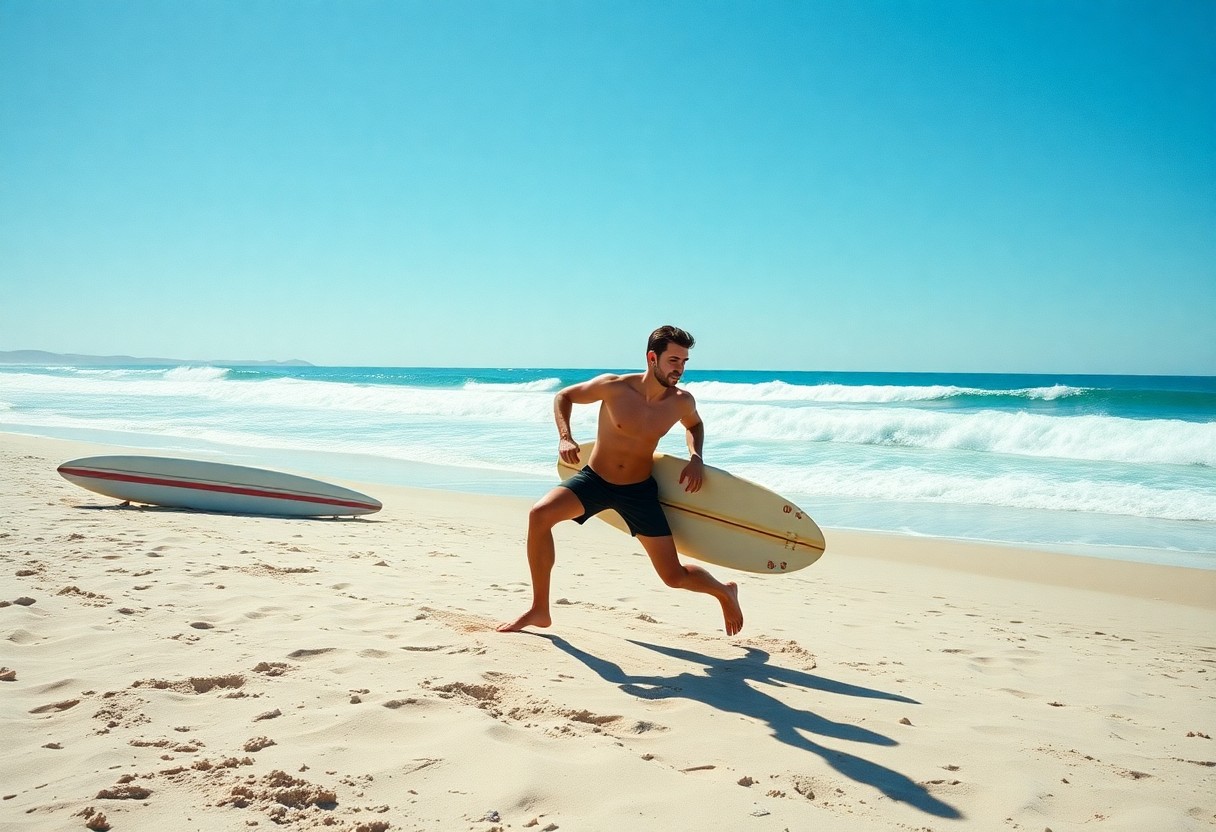Surf your way to better fitness with The Surf-Inspired Interval Workout Everyone Needs, designed to boost your endurance and agility by mimicking the dynamic movements of surfing. This workout combines high-intensity intervals with recovery phases to challenge your cardiovascular system and build strength. Intense bursts of effort followed by quick rest periods not only improve your stamina but also help prevent overtraining injuries. By incorporating these surf-style exercises, you’ll enhance your balance, coordination, and mental focus, making it an ideal routine whether you’re hitting the waves or just aiming for peak physical condition.

Harnessing the Rhythm of the Waves
The undulating pattern of ocean waves provides a natural template for structuring your interval workouts. Just as each wave builds slowly before crashing, your efforts during training should mirror this ebb and flow, alternating between explosive bursts and steady recovery phases. By syncing your intervals with the rhythm of the sea, you not only optimize your cardiovascular efficiency but also cultivate a mental cadence that reflects the fluidity needed for surfing. This approach encourages you to tap into a natural tempo, pushing your limits during the high-intensity surges while allowing necessary recovery that prepares your muscles for the next wave of effort.
Incorporating specific movements borrowed from surf training routines lets your body develop the precise muscle memory required for the board. Exercises like pop-ups, paddling simulations, and rotational core work simulate the demands of wave riding while enhancing your overall conditioning. For a detailed guide on exercises tailored to elevate your surf performance, check out this Surf Workout: Surfing Exercises to Improve your Surfing, which offers targeted drills designed to increase your power and endurance in the water.
The Connection Between Surf Culture and Fitness
Surf culture is deeply intertwined with a lifestyle that values physical preparation as much as the thrill of catching waves. The demanding nature of surfing—balancing, paddling, and maneuvering—means fitness extends beyond building strength to mastering balance, endurance, and agility. Communities surrounding surf spots often embrace fitness regimens that reflect these needs, creating a culture where cross-training, functional workouts, and mindfulness practices coexist. This careful attention to body mechanics and recovery fosters a holistic approach that keeps surfers at their peak and immersed in the vibrant lifestyle.
Moreover, the social aspect of surf culture influences your motivation to stay fit. Group sessions and competitive events encourage you to challenge yourself while connecting with others who share your passion. This camaraderie not only drives consistency but also promotes learning through sharing techniques, tips, and new workout styles rooted in surfing itself. By engaging in this vibrant community, your fitness routine becomes more dynamic and inspired, enhancing your overall connection to the sport.
The Science of Interval Training Explained
Interval training alternates between periods of intense activity and brief recovery, producing significant cardiovascular benefits and improving muscular endurance. Research demonstrates that high-intensity intervals increase VO2 max, the maximum rate of oxygen consumption, which directly translates to better stamina in the water. For surfers, this means more paddle power and quicker recovery between waves, enabling you to extend your time on the board while maintaining sharp responsiveness.
Another physiological advantage emerges through the repeated oxygen debt and repayment cycle inherent in intervals. This process trains your body to clear lactic acid more efficiently, delaying fatigue during those crucial moments when you need explosive strength to catch and ride waves. The combination of anaerobic bursts and aerobic recovery phases mirrors the natural demands of surfing, making interval training uniquely beneficial for your performance.
Scientific studies underpinning the practical application of interval training reinforce its superiority over steady-state cardio for aquatic sports athletes. Implementing periodized intervals—varying work and rest ratios—promotes muscle fiber recruitment and neuromuscular adaptation critical for quick, powerful movements. Understanding these mechanisms allows you to tailor your workouts precisely, maximizing the transfer of fitness gains from land training directly into your surfing skillset.
Crafting Your Surf-Inspired Routine
Essential Components of the Workout
At the core of a surf-inspired interval workout lies a combination of cardiovascular endurance, explosive strength, and dynamic balance training. Start by integrating high-intensity bursts, such as sprint paddling or simulated pop-up jumps, that replicate the sudden paddling and explosive takeoff needed in real surfing. These segments should be paired with active recovery periods that mimic the slower, sustained paddling you do while waiting for waves. Incorporating bodyweight exercises like burpees, jump squats, and plank variations helps you develop the power and core stability vital for maintaining control on your board.
You’ll also want to include movements that challenge your proprioception and balance, such as single-leg stands on a wobble board or stability ball exercises. These not only mimic the unstable environment of the ocean but also enhance your neuromuscular coordination. The integration of breathing drills during low-intensity phases can improve your breath control, which proves beneficial when holding your breath underwater during wipeouts. Structuring these components thoughtfully ensures that your workout effectively simulates the physical demands of surfing.
The Perfect Balance: Alternating Intensity
Successful interval training hinges on carefully timed shifts between high and low intensity. Short bursts of maximum-effort activity lasting 20 to 40 seconds push your anaerobic system, building explosive power crucial for catching waves and quick maneuvers. Follow these with longer, low-intensity intervals of 60 to 90 seconds, which are designed to promote active recovery by maintaining blood flow and reducing muscle acidosis. This balance not only mirrors the fluctuating pace of surfing but also maximizes cardiovascular adaptability.
Implementing a 1:2 or 1:3 work-to-rest ratio in your sessions optimizes endurance without excessive fatigue. For example, a 30-second all-out paddling simulation followed by 90 seconds of moderate rowing or jogging can increase your aerobic base while fostering speed and power. Varying the intensity and duration of intervals keeps your body constantly adapting, mirroring the unpredictable ocean conditions you face during surf sessions.
Spacing intervals with distinct intensity levels enhances recovery and performance alike, making each high-intensity effort more effective. The alternating pattern conditions your energy systems, ensuring you can generate powerful sprints without burning out too quickly and maintain moderate effort levels over extended surf sessions.

Tools of the Trade: Equipment and Setup
Must-Have Gear for a Surf Workout
To replicate the dynamic movements of surfing during your interval workout, a high-quality balance board is indispensable. This tool forces your core and lower body to engage similarly to balancing on a surfboard, training stability and coordination in ways traditional workouts often miss. Pair it with a set of resistance bands to mimic paddling motions, which help strengthen your upper back and shoulders—key areas for powerful surf strokes. Choose bands with varying tension levels so you can increase resistance as your strength improves.
Additionally, incorporating a jump rope enhances your cardiovascular endurance and foot speed, crucial for swift pop-ups and quick directional changes on the wave. Weighted vests provide an extra challenge by adding resistance, boosting muscular endurance and overall power without bulky gym equipment. Combining these elements equips you with a compact, versatile setup that partners perfectly with the interval format and keeps you surf-ready all year round.
Creating an Ocean-Like Atmosphere
To fully immerse yourself in the workout and engage your mind along with your body, recreate the ambiance of the beach environment. Playing surf sounds or ocean waves in the background stimulates your senses, encouraging focus and a rhythm that mimics actual surfing conditions. The auditory cues can also subconsciously prepare your body to adapt to the ebb and flow of interval intensity, much like navigating through swells in the water.
Lighting and space can play subtle but impactful roles in enhancing this atmosphere. Exercising near a window with natural light or using blue-toned lights evoke feelings of open water and sky, boosting mood and energy levels. Clearing a dedicated area for your workout, free from clutter, allows room for dynamic movements and minimizes distractions—just as a clear, open beach space allows for fluid maneuvers on your board.
For an added sensory boost, consider incorporating a light mist spray or installing a small fan to emulate ocean breezes. These tactile elements heighten the realism of your environment, which can increase motivation and training effectiveness by tricking your mind into feeling like you’re training right on the shoreline.
Navigating Challenges: Overcoming Plateaus
Progress in any workout routine rarely follows a straight line, and the surf-inspired interval workout is no exception. You might notice your performance stagnating despite consistent effort. This plateau often stems from repetitive movements that your body has adapted to or from insufficient recovery times between sessions. Recognizing the physical signs—such as persistent fatigue, declining strength, or lack of enthusiasm—signals the need for a strategic adjustment to reignite your gains. Modifying variables like interval duration, rest periods, or incorporating new movements that mimic different surf maneuvers can provide the stimulus your muscles require to grow and adapt further.
Avoiding plateaus also means paying close attention to recovery protocols, including nutrition, hydration, and sleep quality. Surfers know that the ocean demands more than raw power; timing, balance, and reaction speed are paramount. Your workouts benefit from cross-training that boosts these components alongside traditional strength and endurance training. By blending high-intensity intervals with balance exercises, agility drills, and flexibility routines, you nurture the diverse physical skills necessary not just to push past plateaus but to elevate your whole fitness level.
Common Pitfalls and How to Avoid Them
One common error is sticking rigidly to the same workout parameters session after session. While consistency is key, your body thrives on variation. Stubbornly maintaining identical interval times and resistance levels can lead to diminishing returns. You can avoid this trap by rotating different formats—such as tabata intervals one day and pyramid intervals the next—to keep your muscles challenged. Another pitfall lies in neglecting proper form during high-intensity bursts, which often happens when fatigue sets in. Poor technique not only hinders progress but can lead to injury, so scaling back the intensity temporarily to focus on movement quality pays off in the long run.
An often-overlooked challenge is the temptation to push through soreness or minor injuries, which can evolve into setbacks that derail your training. Listening attentively to your body’s signals and integrating active recovery days—like yoga or swimming—helps you avoid these pitfalls. Additionally, a lack of overall fitness diversity may cause imbalances; supplementing your interval workout with cardio sessions or strength training targeting different muscle groups ensures comprehensive development.
Strategies for Keeping Motivation High
Fluctuations in motivation are natural with any demanding regimen, but employing targeted strategies can help sustain your drive to keep progressing. Setting measurable, short-term goals tailored to the surfing-inspired nature of the intervals creates frequent victories that boost morale. For example, aiming to improve your recovery time between intervals by 10 seconds within two weeks offers a tangible challenge. Engaging with a community, whether through local surf clubs, online forums, or workout groups, also invigorates your commitment by exchanging tips, sharing successes, and fostering friendly competition.
Integrating technology can amplify motivation; fitness trackers that monitor heart rate variability, performance metrics, and recovery provide real-time feedback that turns abstract efforts into concrete data points. Visualizing your goals through progress photos or detailed workout logs reinforces your sense of accomplishment. Lastly, occasionally swapping your regular routine for outdoor interval sessions at the beach or surf simulators refreshes your enthusiasm by reconnecting with the sport’s environment and excitement.
To further enhance motivation, consider experimenting with music playlists designed to match the intensity of your intervals—studies reveal that rhythmically aligned tunes can elevate endurance and reduce perceived effort. You might also track your workouts using apps that gamify fitness, converting each session into a quest or challenge. This playful approach reduces monotony and helps turn your interval workout into an engaging, addictive experience that echoes the thrill of riding a wave.

The Role of Recovery in a Surf Lifestyle
Importance of Rest and Restoration
Surfing and high-intensity interval training both place substantial demands on your muscles and nervous system. Without adequate rest, those microtears in muscle fibers caused by paddling, pop-ups, and explosive intervals can’t rebuild as effectively. In fact, studies show that muscle recovery peaks between 24 to 72 hours post-exercise, depending on intensity, so strategically scheduling your rest days allows for optimal gains in strength and endurance.
Your brain also benefits from downtime; neurological fatigue can diminish your reflexes and balance — two non-negotiables when riding waves or performing dynamic workouts. Sleep quality directly influences cognitive restoration, with 7 to 9 hours recommended for athletes to maintain peak alertness during paddling or interval sprints. Skipping restorative phases increases injury risk by up to 40%, emphasizing how non-negotiable recovery truly is for sustained performance.
Incorporating Surf-Inspired Recovery Techniques
Using recovery strategies that mimic the surfing lifestyle amplifies your body’s ability to bounce back. After intense interval training, immersing yourself in cold water — sea water preferred — helps reduce inflammation and muscle soreness by constricting blood vessels. Surfers often perform post-session mobility drills in the sand, focusing on hip openers and spinal twists which improve flexibility necessary for pop-ups and quick directional changes.
Breathwork tailored from pranayama and surfing rhythms supports nervous system regulation during downtime. The classic “box breathing” technique, involving four-second inhales, holds, exhales, and pauses, can lower cortisol and heart rate, speeding recovery and mental reset. Foam rolling the major muscle groups engaged during your surf intervals further decreases myofascial tightness, promoting quicker return to full range of motion and function.
Diving deeper, you can elevate recovery by integrating active water-based rest days — paddling at an easy pace or practicing breath holds underwater not only simulates surfing movements but also maintains circulation without taxing the muscles. Pair these with nutritional strategies emphasizing omega-3 fatty acids and antioxidants from foods like wild salmon and berries to combat oxidative stress, fueling a comprehensive recovery protocol that aligns perfectly with your surf-inspired training.
Final Words
Presently, if you are looking to elevate your fitness routine while embracing the dynamic spirit of the ocean, the surf-inspired interval workout offers a powerful solution. This method aligns perfectly with your desire to build endurance, strength, and agility, all traits that are important not just in surfing but in any active lifestyle. By integrating bursts of intense activity followed by brief recovery periods, you stimulate both your cardiovascular system and muscular strength in a balanced, effective way.
As you continue to refine your approach, consider exploring additional resources tailored to this unique training style. Engaging with dedicated SURF-STYLE TRAINING programs will deepen your understanding and improve your performance, allowing you to fully experience the benefits of interval workouts inspired by the waves. This is an opportunity to transform your workout into an invigorating challenge that keeps you motivated and consistently progressing toward your fitness goals.
FAQ
Q: What is the main focus of The Surf-Inspired Interval Workout?
A: The workout centers on combining cardiovascular endurance and full-body strength by mimicking the dynamic movements involved in surfing. It typically involves interval training with bursts of high-intensity exercises followed by recovery periods, aiming to build stamina, agility, and core strength.
Q: Who can benefit from doing this surf-inspired interval workout?
A: This workout is suitable for individuals of various fitness levels who want to improve their overall fitness, agility, and balance. It’s particularly beneficial for surfers looking for sport-specific conditioning, as well as those seeking an engaging and functional exercise routine.
Q: What types of exercises are commonly included in this interval workout?
A: Exercises often include movements that simulate paddling, pop-ups, squats, lunge jumps, push-ups, and balance drills. These are performed in timed intervals to improve cardiovascular fitness while strengthening muscles important for surfing.
Q: How long does a typical session of this surf-inspired workout last?
A: A typical session ranges from 20 to 40 minutes, depending on fitness level and workout intensity. Interval periods usually last between 20 to 60 seconds with rest or low-intensity recovery going between rounds.
Q: What are the benefits of incorporating this surf-inspired interval workout into a fitness routine?
A: Benefits include improved cardiovascular health, enhanced muscular endurance, better balance and coordination, increased agility, and sport-specific strength for surfers. It also adds variety to workouts, which can help maintain motivation.
Q: Is special equipment needed to perform this workout?
A: Most exercises can be done using just body weight, making the workout accessible with minimal or no equipment. However, optional equipment like resistance bands or balance boards can be introduced for added challenge and to more closely mimic surfing dynamics.
Q: How often should someone perform this surf-inspired interval workout for best results?
A: Performing this workout two to three times per week is effective for building fitness and surf-specific strength. It’s recommended to include rest days or lighter activity days for muscle recovery and to avoid overtraining.
